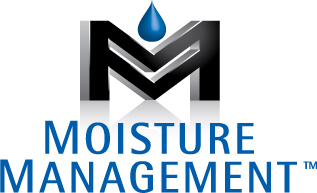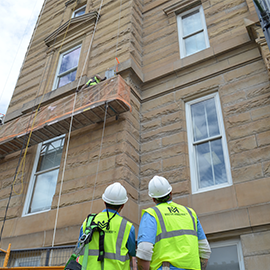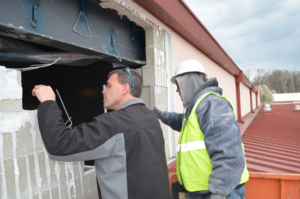When building owners and managers deal with leaks into their interior spaces, the roof usually comes to mind first as the likely cause. However, building leaks can come from many parts of the “building envelope”, which Moisture Management defines as the combination of all above-ground building components, including windows, walls, skylights, and of course, the roof. For a building to remain watertight, all elements of the building envelope must work in tandem and none can be deficient. When a deficiency is found in the building envelope below the roof, a scope of work to make a waterproofing repair needs to be developed and properly executed. This is where the importance of independent waterproofing project oversight comes into play.
Pre-Project Review and Protocols
For complex waterproofing capital and repair projects, such as thru-wall flashings and end-dam replacement inside brick walls, temporary removal of the brick wall is typically required. The brick removal process is expensive, messy, time consuming, and can result in damaged brick, adding even more cost. Therefore, it is critical that: a) the problem has been correctly identified before beginning, b) the proposed scope of work is correct and complete, and c) proper testing protocols are in place to ensure the problem has been rectified BEFORE replacement of the brick has begun.
While many masonry contractors are utilizing the proper mix of professional expertise, industry knowledge, and scientific testing (using infrared cameras, moisture meters, probes, etc.), they may lack the understanding of how various building envelope features interact. For example, a window wall system could be installed wrong on an upper wall that is allowing moisture in, but due to the infrastructure of the building, the water drips out in a completely different spot. If the brick wall is opened where the leak is appearing inside, no repair in that area will fix the window wall issue. Ensuring the scope of work will fix the actual problem and is adequate enough to be effective BEFORE beginning work helps eliminate wasted money on ineffective repairs.
On-Site Waterproofing Project Oversight
Once the project is ready to be begin, having an Independent Waterproofing Expert (IWE) onsite to protect your interests is vital to the success of the new construction or repair project. The IWE protects the customer interests in several ways, from ensuring safety protocols are in place to verifying the materials used in the project match what was proposed in the scope of work. More importantly, the IWE provides quality control assurance by checking the work performed was done correctly and photographically documenting all stages of the project.
Cost of Project Oversight vs. Value Provided
Having independent waterproofing oversight on a capital or repair waterproofing project does add some costs to the overall project, but they are minor in nature when compared to the value realized by ensuring the scope is accurate, preventing an installation mistake, verifying the materials used were what the client paid for, and to have a photographic and professional record of the project, in the event a future problem arises. Finally, unlike the roof and other components, many waterproofing elements cannot be easily accessed without demolition and once the brick or EIFS has been replaced, no further analysis can be performed without incurring significant expense all over again!
Conclusion
Having an independent waterproofing consultant provide professional oversight on capital and repair projects protects your interests, helps prevent contractor errors and malfeasance, and provides you with a fully documented record of the project. Given the difficulty of access, the costs associated with such repairs, and the technical knowledge required to correctly diagnose the problem in the first place, waterproofing repairs need to be completed correctly the FIRST time. Hiring an independent waterproofing consultant greatly increases the odds that your next project will accomplish that goal.








